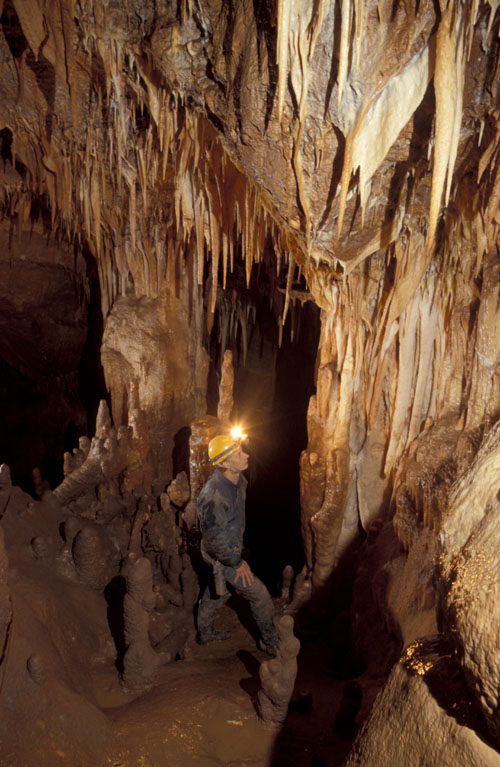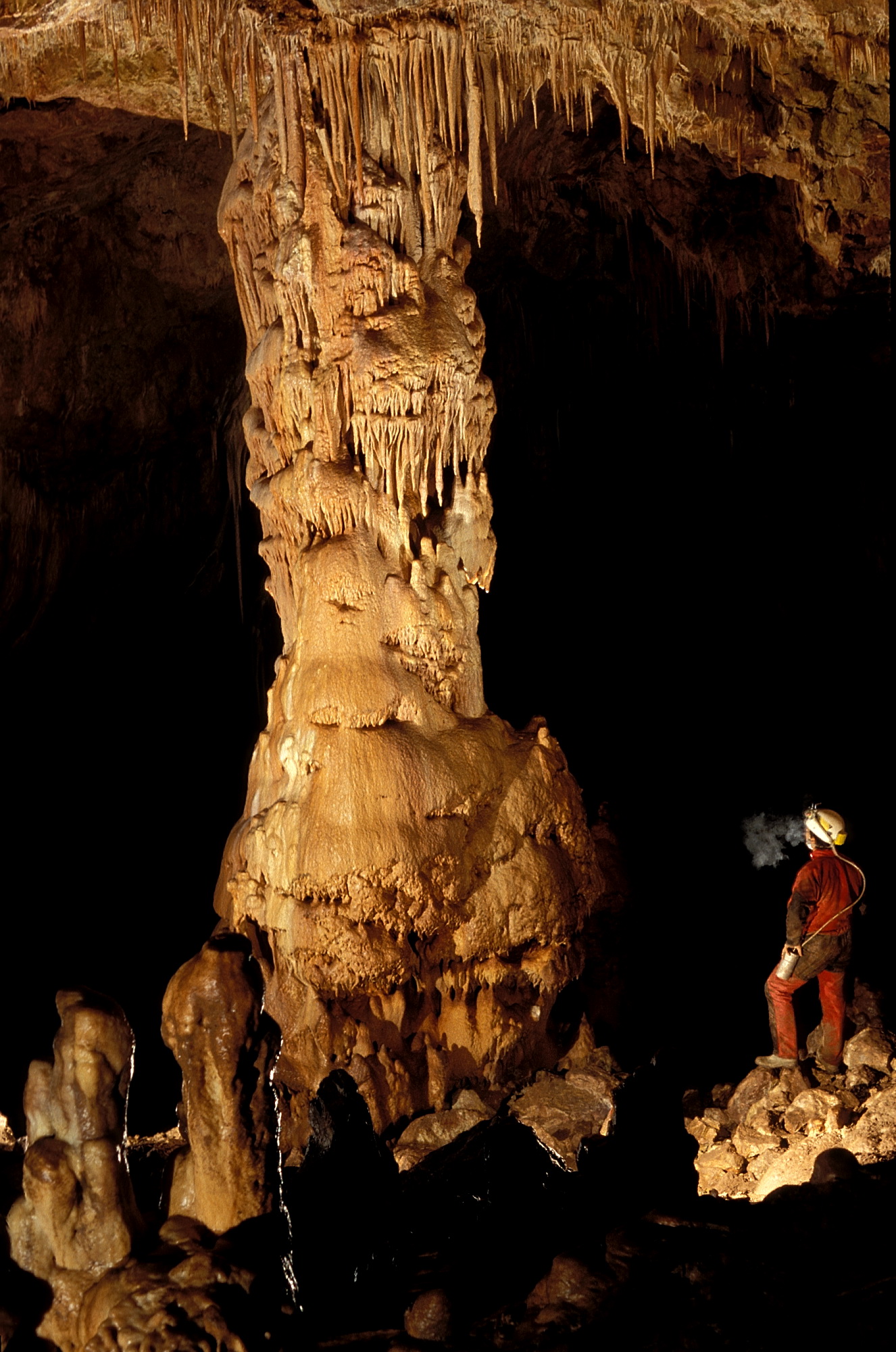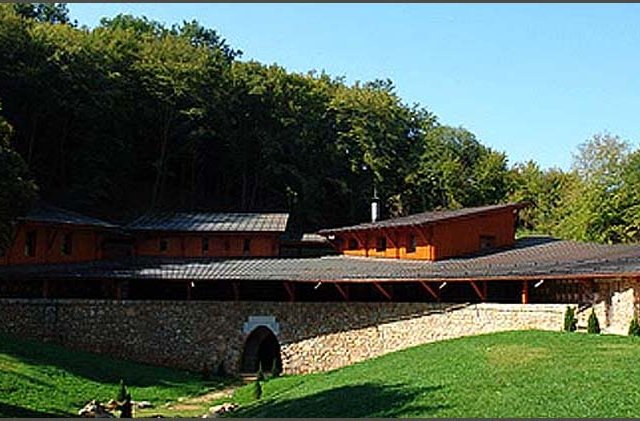
The Meteor Cave
 Discovery and Exploration
Discovery and Exploration
Situated on Alsó-hegy (Alsó Hill), hidden by the Kisvizes dolina (A closed, steep-sided and flat-floored depression in karst country) at the foot of a cliff lies the Meteor Cave - the most important sinkhole in the region.
In 1961, György Dénes along with members of the Red Meteor Cave Research Department, began excavation of the intermittently active drain entrance. Following a week of intense work, Gábor Frojimovics and György Kovács became the first to enter the cave system on August 6. No obstacles blocked the passage between the massive stones, and they descended 10 m into the pit. During the following days, the group secured vertical ladders into place and entered a monumentally large hall. This section was later named “The Hall of Titans” for the massive stalactites adorning its ceiling. At this time, lack of appropriate equipment forced them from delving further.
Between November 4-9, the explorers continued another half kilometre into the system. From the Hall of Titans, one member succeeded in crawling another 50 m into a large crevice where incredibly rich stalactite formations progressed until it met up with another vertical section. In the interest of speeding up the research, they organised a 120 hour underground expedition from January 29 to February 3, 1962. This time, they succeeded in entering the vertical shaft to a depth of about 155 m. This put the Meteor ahead of the Money Stream Sinkhole, making it the 13th deepest cave in Hungary. Subsequent camps explored smaller side passages and secured the work of the previous teams. By 1963, researchers had already managed to journey 1 km into the system.
Unfortunately, along the way the cave claimed several victims. Mária Winkler suffered a 12 m fall in the autumn of 1961. After 24 hours, rescuers succeeded in bringing her back to the surface. Although her injuries were serious, she recovered quickly. On November 3, 1969 László Lakatos fell in the section below the Hall of Titans and suffered serious head injuries. Fifty people working for 14 hours managed to bring him up, but even after careful medical treatment, he died in hospital two months later. The Lakatos Spring bears his name, and there is a memorial plaque at the Paul Valley Cave (Pál-völgyi).
The Natural Environment
György Szentes, ELTE geology professor and founding member of the Meteor Cav Research Club, actively took part in the geological analysis and exploration of the system for many
years. The Meteor Cave’s sometimes debris-strewn chambers were formed in Wetterstein Middle Triassic and Upper Triassic Hallstatt limestone. The system consists of two major parts. In the first, the younger part from the entrance to the first shaft, the passage is wide but not too high and decorated in places with dripstones. The famous Hall of the Titans occupies the lower part of this gradually deepening cave. To the south-southeast, the chain of chambers (Monkey, Debris, Skew, Great Hall) are in direct hydrological connection with the entrance to the sinkhole. However, these areas are now completely clogged, and there is no evidence of them on the surface. The infiltration of water into the lower parts of the system is steadily climbing up through, and consolidating the rubble. The upper funnel-like zone of rubble merges with and ends in a connecting flight of stairs.
The Hall of the Titans
During periods of heavy rain, the first shaft manifests a waterfall. This narrow but high corridor, after a smaller 3 meter area of fragmentation flattens out and connects with a 10 m deep shaft. Normal spray from the waterfall also gets into the Hall of the Titans, the second largest cave chamber in Hungary.
The eponymous 10-15 m high stalagmite columns are found in the north-northeast area of the 110 m long, 20-30 m wide contiguous Hall of Titans. The huge diversity of dripstone forms among the monumental columns including bamboo- and straw-shaped dripstones, draperies, pools and heliktites cannot fail to make an unforgettable impression on visitors. The mesmerizing sight of free standing and hanging straw formations, as well as masses of heliktites enhances the already stunning appearance of the chamber.
The Flat Room
One-third of “Flat Room” is marked by a huge slope of an ancient collapse of the chamber ceiling. Buried under the debris and huge blocks in this vertical fracture is probably a rich testament to the room’s former dripstone treasures. The rough rock surface is covered with a thin layer of rubble, and several square meters of the ceiling is decorated by heliktit “herbs” and “bouquets.” In a distinct area of the east-west section, it merges with a gloriously active area. Sharply rising for 20-30 m, one encounters several branches partially filled with debris that have filtered down from the upper zone.
The second pit drains water from the room, and after a new 10 m drop through a narrow passage, digs itself an independent creek bed. Below the Flat Hall, and after several smaller breaks, sediment is washed out and the creek becomes a trickle at about 121 m. The deepest point of the cave, 127 m, is in the north-east corner. There, a cleft leads to two small (8, 10 m) shafts and the “Clay Hall” distinguished by its clay substrata and stalactites.
The average temperature in the cave is 10.4 ˚C (50.7 ˚F), and the relative humidity is 95.3%.
Hydrology
The hydrological connections were first mapped in the summer of 1961, when researchers placed 1.5 kg of fluorescent dye in the Hall of Titan’s deepest point and it showed up in the creek but not the springs. However, in the spring of 1964, a clear hydrological connection was detected between the cave and the 237 m deep Vecsem Spring 1790 meters away. In order to reach the spring at the karst water level though, researchers must somehow go another 100 meters deeper.
Flora and Fauna
Thanks to the relatively broad catchment area and soil conditions around the Meteor Cave, abundant sources of food are available for cave dwelling creatures and plants. Wildlife researcher Daniel Bajomi’s survey used traditional collection techniques to examine the sediments (substrata) for living species and achieved very good results in terms of both recorded species and their populations. For example, there are between 9 and 15 types of springtails (hexapods) and nematodes (roundworms). In particular, large numbers of Arrhopalites hungaricus intermedius springtail are prevalent. In addition, there are many types of Diptera (flies), and typical cave beetles such as the Duvalius hungaricus silicensis, Trechus micros, Atheta spelaea, Lastera longelytrata and Eukoenenia austriaca vagvoelgyii present. Moreover, he found many kinds of mites and roundworms, but oddly did not locate any Mesoniscus granige. Noteably, Bajomi discovered two new crabs species: the Elaphoidella pseudojeanneli and the E. meteori, and he provided the first recorded observation of the Niphargus tatrensis (a troglobitic species of crustacean) in Hungary. This discovery immediately brought into question if the N. aggtelekiensis is in fact a separate species. He surveyed 90 animal species, 13 of which were troglodytes.
(ANPI archive, Csaba Egri)



